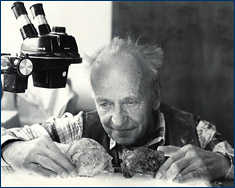 |
|
|
Karl Hirsch and the Hirsch Eggshell Collection |
 Karl Hirsch in 1988 studying 140-million-year-old dinosaur eggs. |
Karl was born in Berlin, Germany where his interest in geology began. Initially, he and his wife, Hildegard, collected minerals. They later turned to collecting fossils; ammonites were some of Karl's favorites. He and Hildegard immigrated to the United States after World War II and eventually ended up in Colorado in 1960, where he worked for the Department of Energy's Rocky Flats Plant. Karl's interest in fossil eggs arose from a specimen his wife found while scouting around in the Willwood Formation of Wyoming. Interested in learning more about their find, they quickly discovered that no one was able to identify the egg or determine which animal might have laid it. Karl was driven to learn more about the egg, thus embarking upon his 20-year career studying the structure and classification of eggs and eggshell.
Despite never attending university in Germany, Karl continued to collect and research fossils on his own. While working full time at Rocky Flats, Karl pursued his interest in paleontology by auditing several classes at the University of Colorado at Boulder and working with the Denver Museum of Nature and Science (then called the Denver Museum of Natural History) and later with the University of Colorado Museum of Natural History. At the University of Colorado, he found a life-long mentor and friend in Dr. Judith Harris, then professor of natural history. Under her tutelage and encouragement, Karl began publishing papers about fossil and recent eggs. Hans-Peter Schultze (from the University of Kansas, Lawrence) and Mary J. Packard (from Colorado State University) were also good friends, professional consultants, collaborators, and advocates of Karl's research. The guidance, collaboration, and advice of these individuals allowed Karl to lay the groundwork for his unique contribution to the field of paleontology. In subsequent years, numerous other paleontologists greatly assisted Karl in his research. Karl had a forceful presence and was relentless in his pursuit of answers to questions.
Karl began donating the specimens he had described in his research to the University of Colorado Museum in 1979, and was named a Museum Research Associate in 1984. He was also a research associate at the Denver Museum of Nature and Science. Through his work, he became well known in the field of fossil eggshells, and his contributions to the field earned him an honorary doctorate from the University of Colorado at Boulder in 1990.
Over the years, Karl amassed a large, diverse collection of recent and fossil eggshells from around the world. The uniqueness of the collection lies not only in its size, but in the temporal and geographical diversity of the fossil materials (see Table 1 under "Fossil record of amniote eggs"). Many of the fossil specimens were collected by Karl himself. He conducted extensive fieldwork throughout the Western Interior of North America, and abroad in Germany, England, Spain, and Portugal. Other specimens came from collaborations with colleagues and donations from scientists, amateur collectors, and institutions. Eggs or eggshell from living animals were obtained from zoos, research labs, breeding facilities, and scientists around the world. In addition to the eggs and eggshells, the collection includes specimen photos, locality data, thin sections, thin section photos, SEM (Scanning Electron Microscope) negatives, SEM stubs, radiographic images, and geochemical data, as well as Karl's personal research notes and correspondence. Most of the thin sections and photos were processed and taken by Karl, but he collaborated with numerous students and colleagues, including Emily Bray who worked closely with him on the collection. Technicians at local medical facilities aided Karl in collecting X-ray and CT scan data. Karl passed away in 1996, but the Karl Hirsch Eggshell Collection lives on at the University of Colorado Museum of Natural History, and is one of the finest eggshell collections in the world.
Noteworthy publications
Hirsch, K.F. 1983. Contemporary and fossil chelonian eggshells. Copeia 2:382-397.
Hirsch, K.F. 1996. Parataxonomic classification of fossil chelonian and gecko eggs. Journal of Vertebrate Paleontology 16(4):752-762.
Mikhailov, K.E., E.S. Bray, and K.F. Hirsch. 1996. Parataxonomy of fossil egg remains (veterovata): Principles and applications. Journal of Vertebrate Paleontology 16(4):763-769.
 |
|
 |
|
 |
|
 |
| Fossil eggshell home | Karl Hirsch and the Hirsch Eggshell Collection | Case studies | Interactive map |
All photos courtesy of the University of Colorado Museum.